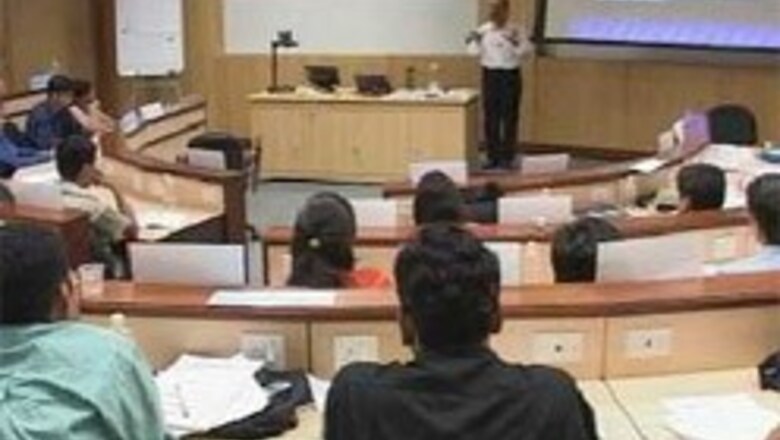
views
New Delhi: The Common Admission Test (CAT) is considered the toughest among MBA examinations. This year it will be held on November 19 and its duration will be two-and-a-half hours instead of two hours. Aspirants need to change their preparation methodology. According to experts, students will have to focus on accuracy more than speed.
A CAT aspirant's biggest worry remains the pattern of the paper, which changes almost every year. In 1998, it had four sections and now it has dropped down to three. The number of questions has also dropped than it was earlier. This means the questions have become longer than before.
Questions are based on verbal ability and reasoning, reading comprehension, qualitative skills, data interpretation, analytical and logical reasoning.
According to experts, the key to success is that the students should try to understand the questions instead of just cramming formulas.
Focus on accuracy and comprehension, but the ability to think logically is important. You can improve these things with some practice. You need to score at least 50 per cent at the graduation level to sit for the CAT exam.
Write to us or call us on 0120-4341895 for your queries on CAT 2006. Our experts from top Management training institutes will answer them on Breakfast with India between 8 am and 10 am (Nov 9-Nov 18).
PAGE_BREAK
To qualify for the interview and Group Discussion, a candidate who is either Scheduled Caste (SC), Scheduled Tribe (ST) or physically disabled will have to score at least 17 per cent and the total aggregate should be 33 per cent.
The general category students need to score 25 per cent in each subject, while total aggregate should be 33 per cent.
Verbal Ability and Reading Comprehension
As the name suggests, one should have a very rich vocabulary and good grammatical skills. Last year there were just 30 questions in the Verbal section, of which only 12 were for Reading Comprehension (RC).
Observe the format for RC questions and make notes to help you understand the difference between direct questions (the answers can be found in the passage) and inference questions (the answers are not directly stated but must be understood in context of the passage).
Pick all the RC passages you have done and categorise them into various topics including economics, philosophy, psychology, medicine, biotechnology, management, religion, language and art, sociology, history, science, politics and general topics.
PAGE_BREAK
Last year, the section was worth 50 marks and out of it 18 questions were worth 30 marks. The questions, which are in the sections, are like sentence correction, sentence sequencing and verbal reasoning. To score well in this, you don't need to be an expert on grammar. But work at developing your abilities in the functional usage of words, idioms and phrases.
This can be achieved by going through any book that gives a summary of the rules of grammar. Thompson and Martinet's Practical English Grammar would be good starting point. CAT coaching institutes also provide such books on grammar
The other way to start building up your vocabulary is to read Word Power Made Easy by Norman Lewis. In addition, you can read All About Words by Rosenblum and Nurenberg or any books by Wilfred Funk. You will find these words in any newspaper and not just in editorials but also in sports pages.
Hence it is the diligence with which you jot down these words, when you encounter them and revise them regularly that will help you prepare for this area.
Data Interpretation and Logical Ability
To start with, you should know how to interpret various data formats. You should be comfortable with tables, line graphs, bar graphs, pie charts, three dimensional graphs, flow diagrams and cumulative frequency tables.
Normally, Data Interpretation (DI) accounts for 25 to 30 marks and LA/ DS accounts for the rest. However, these days, it is sometimes difficult to differentiate between DI and Logic.
In CAT 2005, there were no Data Sufficiency questions. DI is a skill and it requires continuous practice.
However, trends have changed and now you have to have a very good understanding of the question and solving the same would put your logical ability to the test.
The key to doing well in logic is similar. You need a methodology to solve logic questions, as well as regular practice in solving a wide variety of questions. The most important thing you should do is that you understand the data and represent the key data in symbolic form, so that you have a summary of the given data before solving the problem.
Focus on what the questions require of you, before starting the solving process - this in turn will help you to solve the problem and save a lot of time. Mastering these skills requires a lot of practice and the mock CAT could help.
Quantitative Ability also called Quant
Though the section is full of mathematical questions, this doesn’t mean that to score well, you need to have good calculating skills but in fact the section also puts to test you reasoning skills and your approach towards the question.
Does the Quantitative Ability section worry you and numbers, geometry and algebra make you nervous? To resolve your anxiety, all you need to do is work proactively.
First, tackle your fears. Then start solving problems in a systematic manner.
This section is worth 50 marks and has been divided into four sections.
Number, (geometry and mensuration), arithmatic, algebra and pure maths.
Geometry and mensuration
For the first section, which is geometry and mensuration - you need to be thorough with the formulae. If you want, then take help from the Trishna Book on Quantitative Ability.
The other section consists of equations, ratio proportion and variation, percentages, profit and loss, averages mixtures, simple interest and compound interest, time and work and time and distance. The section also consists of algebra, indices, logs and quadratic equations, progressions, special equations and inequalities to deal with.
The last and the fourth section deals with pure maths and have functions and graphs, number systems and coordinate geometry.
It may be heartening to note that in CAT, the cut-off for Quant never goes beyond 12 marks (out of 50).
There have been times when the cut-off for Quant was as low as eight marks. Besides, the fact that you have close to 40 minutes for Quant, and a range of 12 to 15 should give you enough confidence to attack this section.
Last but not the least, there is no shortcut to success or mathematics. Speed techniques and supposed shortcut formulae don't help in CAT. ####Crack the CAT examination  India’s best management institutes
India’s best management institutes ![]() Top B-schools in India
Top B-schools in India




















Comments
0 comment